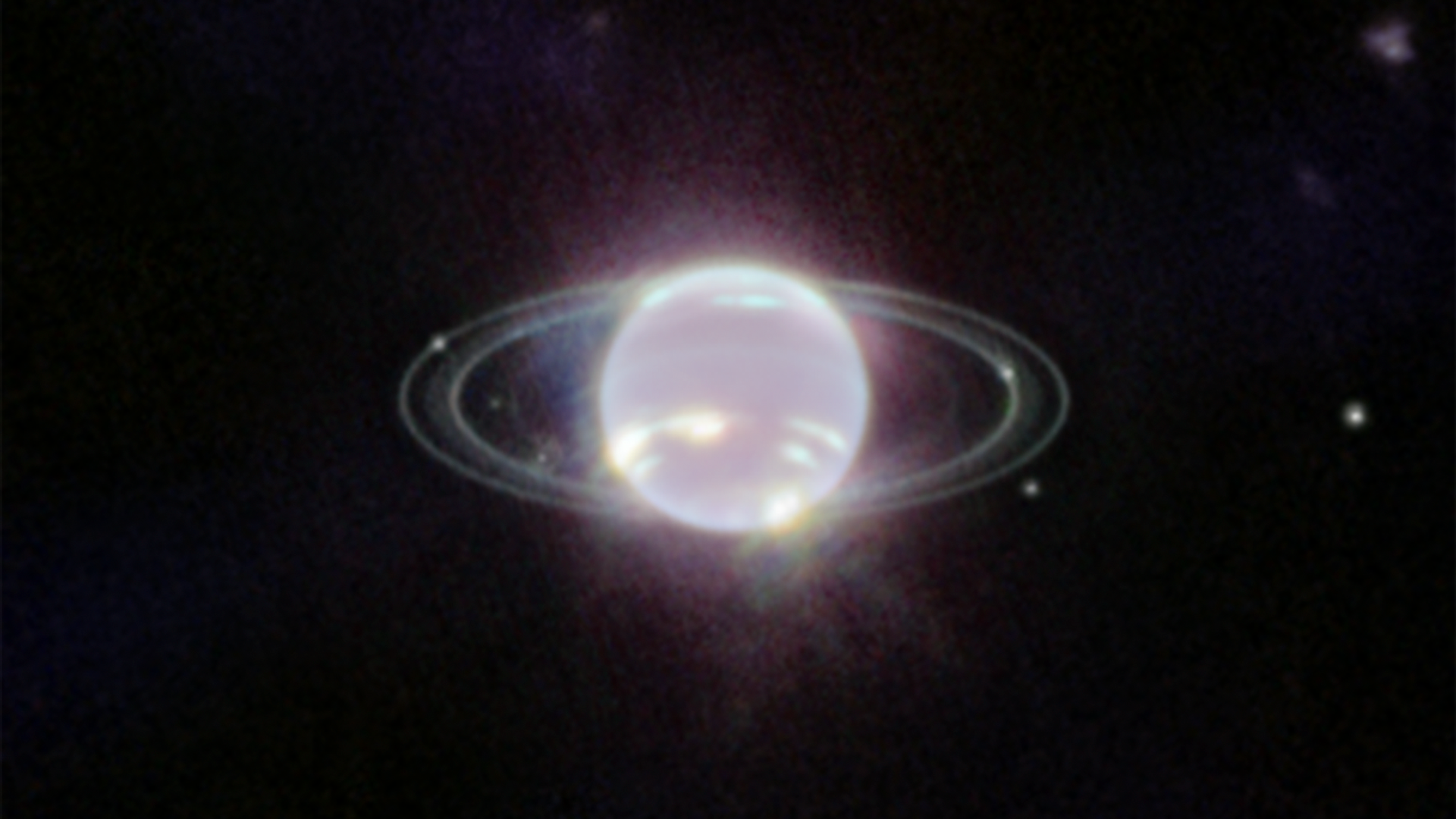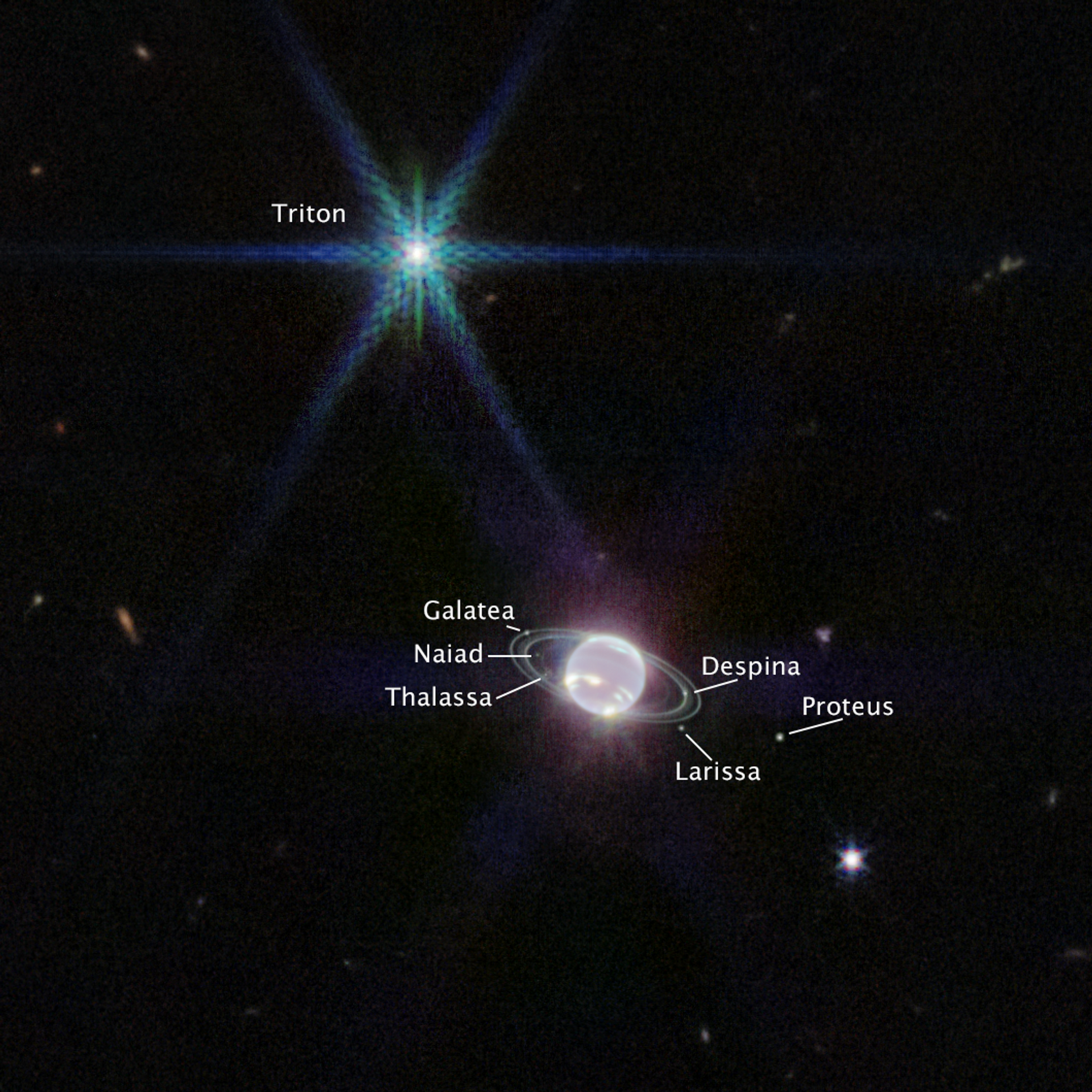https://sputnikglobe.com/20220922/fresh-james-webb-telescope-photo-shows-neptunes-rings-in-stunning-quality-1101066625.html
Fresh James Webb Telescope Photo Shows Neptune's Rings in Stunning Quality
Fresh James Webb Telescope Photo Shows Neptune's Rings in Stunning Quality
Sputnik International
When NASA's Voyager 2 probe flew by Neptune in 1989 on its way out of the solar system and into interstellar space, it was the last time the rings of Neptune... 22.09.2022, Sputnik International
2022-09-22T03:17+0000
2022-09-22T03:17+0000
2023-04-12T16:58+0000
science & tech
nasa
nasa probe
pluto
planet
solar system
rings
james webb space telescope
space
https://cdn1.img.sputnikglobe.com/img/07e6/09/16/1101066863_0:88:1680:1033_1920x0_80_0_0_cdfdee7a1e8aa753bf0cca22b67a620a.png
NASA has released the first photographs of Neptune, the mysterious ice giant that orbits in the remote regions of the outer solar system, taken by the James Webb Space Telescope. According to the agency's news release, the photographs from the observatory, which were made public on Wednesday, offer some of the sharpest views of Neptune's rings in more than 30 years.Infrared wavelengths, which can see through gas and dust that could otherwise obscure astronomical features, were used to photograph Neptune's rings. With the use of its infrared equipment, the Webb telescope can observe planets, stars, and galaxies invisible to the human eye and other telescopes that primarily use visible light.The Webb observatory discovered seven of Neptune's 14 confirmed moons in addition to the planet's shiny rings and fainter dust bands. Thus, Neptune is now visible to astronomers in considerably greater detail.These incredibly weak rings were discovered so close to Neptune thanks to Webb's exceptionally stable and accurate image quality, according to NASA.In fact, the planet is fairly opaque at these near-infrared wavelengths due to the substantial absorption of red and infrared light by methane gas, with the exception of areas with high-altitude clouds. These bright streaks and spots of methane-ice clouds are noticeable because they reflect sunlight before it is absorbed by methane gas, the agency noted.Over the years, images from other observatories, including the W.M. Keck Observatory and the Hubble Space Telescope, have captured these fast-changing cloud structures.According to NASA, a tiny bright line near Neptune's equator may show where the atmosphere is warming and emitting infrared light as opposed to the cooler gas around it. These features could represent physical manifestations of the planet's atmospheric circulation, which might also be the source of Neptune's winds and storms. NASA experts said that the Webb observatory saw a continuous band of clouds surrounding a previously observed vortex at Neptune's southern pole. In addition, a bright region close to the planet's northern pole needs to be observed again.A number of Neptune's moons, including Galatea, Naiad, Thalassa, Despina, Larissa, and Proteus, are also discernible in the image. The moon Triton, which shines brighter than Neptune because it is covered in a frozen covering of condensed nitrogen and reflects more sunlight than the planet and its atmosphere, may be seen in one photograph as a bright blue spot that appears to be a star."Wow, I am in awe of those rings!" wrote Thomas Zurbuchen, associate administrator of NASA’s Science Mission Directorate.Triton reflects about 70% of the sunlight that it receives. The moon's peculiar retrograde orbit around Neptune has led astronomers to hypothesize that it was once a Kuiper belt object that was gravitationally grabbed by Neptune. In the upcoming year, more Webb observations of Triton and Neptune are anticipated.The planet Neptune, which is 30 times further from the Sun than Earth, was discovered in 1846. The planet travels through some of the outer solar system's remotest and darkest regions throughout its 164-year orbit. Because of the chemical makeup of its interior, Neptune is referred to as an "ice giant." According to NASA, Neptune is richer in elements heavier than hydrogen and helium than Jupiter and Saturn, the gas giants of the outer solar system.
https://sputnikglobe.com/20220531/new-study-reveals-why-neptune-is-a-deeper-blue-than-uranus-1095907113.html
Sputnik International
feedback@sputniknews.com
+74956456601
MIA „Rossiya Segodnya“
2022
News
en_EN
Sputnik International
feedback@sputniknews.com
+74956456601
MIA „Rossiya Segodnya“
Sputnik International
feedback@sputniknews.com
+74956456601
MIA „Rossiya Segodnya“
science & tech, nasa, nasa probe, pluto, planet, solar system, rings, james webb space telescope, space
science & tech, nasa, nasa probe, pluto, planet, solar system, rings, james webb space telescope, space
Fresh James Webb Telescope Photo Shows Neptune's Rings in Stunning Quality
03:17 GMT 22.09.2022 (Updated: 16:58 GMT 12.04.2023) Kirill Kurevlev
Managing Editor
When NASA's Voyager 2 probe flew by Neptune in 1989 on its way out of the solar system and into interstellar space, it was the last time the rings of Neptune were seen in such detail. The eighth planet in the solar system was first seen up close by humanity during that momentous visit.
NASA has released the first photographs of Neptune, the mysterious ice giant that orbits in the remote regions of the outer solar system, taken by the James Webb Space Telescope.
According to the agency's
news release, the photographs from the observatory, which were made public on Wednesday, offer some of the sharpest views of Neptune's rings in more than 30 years.
Infrared wavelengths, which can see through gas and dust that could otherwise obscure astronomical features, were used to photograph Neptune's rings. With the use of its infrared equipment, the Webb telescope can observe planets, stars, and galaxies invisible to the human eye and other telescopes that primarily use visible light.
The Webb observatory discovered seven of Neptune's 14 confirmed moons in addition to the planet's shiny rings and fainter dust bands. Thus, Neptune is now visible to astronomers in considerably greater detail.
“It has been three decades since we last saw these faint, dusty rings, and this is the first time we’ve seen them in the infrared,” Heidi Hammel, who is an interdisciplinary scientist with Webb, is quoted in the release as saying.
These incredibly weak rings were discovered so close to Neptune thanks to Webb's exceptionally stable and accurate image quality, according to NASA.
In fact, the planet is fairly opaque at these near-infrared wavelengths due to the substantial absorption of red and infrared light by methane gas, with the exception of areas with high-altitude clouds.
These bright streaks and spots of methane-ice clouds are noticeable because they reflect sunlight before it is absorbed by methane gas, the agency noted.
Over the years, images from other observatories, including the W.M. Keck Observatory and the Hubble Space Telescope, have captured these fast-changing cloud structures.
According to NASA, a tiny bright line near Neptune's equator may show where the atmosphere is warming and emitting infrared light as opposed to the cooler gas around it. These features could represent physical manifestations of the planet's atmospheric circulation, which might also be the source of Neptune's winds and storms.
NASA experts said that the Webb observatory saw a continuous band of clouds surrounding a previously observed vortex at Neptune's southern pole. In addition, a bright region close to the planet's northern pole needs to be observed again.
A number of Neptune's moons, including Galatea, Naiad, Thalassa, Despina, Larissa, and Proteus, are also discernible in the image.
The moon Triton, which shines brighter than Neptune because it is covered in a frozen covering of condensed nitrogen and reflects more sunlight than the planet and its atmosphere, may be seen in one photograph as a bright blue spot that appears to be a star.
"Wow, I am in awe of those rings!" wrote Thomas Zurbuchen, associate administrator of NASA’s Science Mission Directorate. Triton reflects about 70% of the sunlight that it receives. The moon's peculiar retrograde orbit around Neptune has led astronomers to hypothesize that it was once a Kuiper belt object that was gravitationally grabbed by Neptune.
In the upcoming year, more Webb observations of Triton and Neptune are anticipated.
The planet Neptune, which is 30 times further from the Sun than Earth, was discovered in 1846. The planet travels through some of the outer solar system's remotest and darkest regions throughout its 164-year orbit.
Because of the chemical makeup of its interior, Neptune is referred to as an "ice giant." According to NASA, Neptune is richer in elements heavier than hydrogen and helium than Jupiter and Saturn, the gas giants of the outer solar system.



